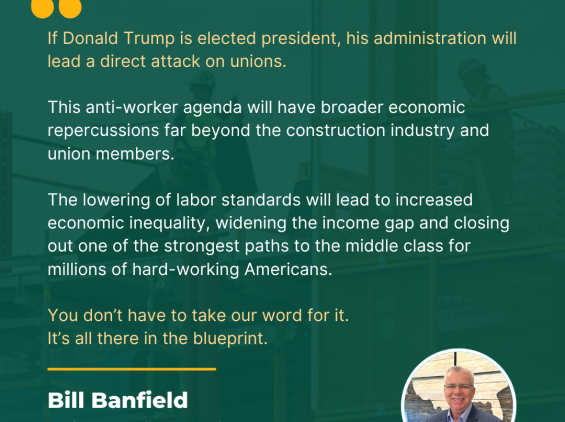A strong union needs skills, benefits and ACTION!

Op-ed | A threat to blue collar workers | By Bill Banfield
October 8, 2024
Any carpenter with any real experience understands that when a contractor puts together a detailed blueprint, he’s going to expect you to follow it. So when Donald Trump’s policy advisors issued their blueprint for his second term, those of us in the building trades took notice. Anyone who spends that much time putting together a set of plans is going to use it.
The blueprint for Trump’s second term is called Project 2025, a 900-page document that was produced by the Heritage Foundation – the same conservative think tank and officials who shaped Trump’s agenda last time around. There’s a lot in there that’s relevant to the construction industry and blue collar workers. Project 2025 is an exhaustive checklist of policies that have been pushed since 1980 to systematically chip away at the labor movement and erode workers’ rights.
Remember how Trump promised to do big things on infrastructure, but never delivered? President Biden and Vice President Harris delivered, with the largest investment in the nation’s infrastructure in 60 years and historic investments in the clean energy and manufacturing jobs of the future – but Project 2025 would roll back the Bipartisan Infrastructure Law and the Inflation Reduction Act. All those blue collar jobs will go away, and that spending on infrastructure will be cut to pay for tax cuts for Trump’s rich friends.
That’s just the start of it. Project 2025 aims to reshape federal policy through an anti-worker lens, which is bad news for working Americans. The plan includes several key policy objectives that directly impact blue collar workers.
Project 2025 would decertify labor unions; pass national ‘right-to-work’ legislation; and let states ban labor unions (page 167, 637). That’s the first step in rolling back a century of labor protections – and it’s the culmination of a movement that the Heritage Foundation has been leading since the 1980’s. These so-called ‘right-to-work’ laws have long been pushed at the state level to weaken union negotiating power by undermining the ability of unions to represent their members effectively. By reducing the influence of organized labor, workers will have diminished leverage in bargaining, which will lead directly to stagnant wages and fewer benefits.
Project 2025 would make it easier to misclassify workers as independent contractors; make it harder for workers to claim overtime; and make it harder to hold joint employers accountable for cheating workers out of overtime, wages, or benefits(page 591). Dishonest contractors frequently cheat on their taxes by misclassifying as independent contractors instead of employees. It’s a way to juice profits by cutting corners, and the lack of accountability makes it easier to cheat workers out of the wages and benefits they’ve earned.
Project 2025 would repeal Davis-Bacon and end project labor agreements (page 604). The Davis-Bacon Act was first passed in 1931, establishing a prevailing wage for federal public works projects. Prevailing wage laws ensure that if a project is built with public funds, workers on that project are paid a decent wage. Project Labor Agreements have been used for decades in public and private construction as a commonsense measure to keep major projects on time and on budget.
Project 2025 would allow the federal government to grant waivers to states to evade worker protections guaranteed by the National Labor Relations Act (NLRA) and Fair Labor Standards Act (FLSA). The NLRA and FLSA are the very foundation of worker protections in America – providing private-sector workplaces the fundamental right to seek better working conditions and establishing minimum wage, overtime pay, and child labor protections.
If all that isn’t enough, Donald Trump has expressed public support for firing striking workers. Just last month, Trump told Elon Musk, “They go on strike, and you say, ‘That’s OK, you’re all gone. You’re all gone. So, every one of you is gone.’”
That is the textbook definition of anti-worker.
For more than a century, unions have been the backbone of the middle class. Unions advocate for basic protections that end up helping all workers, not just union members. And by promoting a higher standard of training and performance, we help strengthen the construction industry and the economy as a whole.
If Donald Trump is elected president, his administration will lead a direct attack on unions. This anti-worker agenda will have broader economic repercussions far beyond the construction industry and union members. The lowering of labor standards will lead to increased economic inequality, widening the income gap and closing out one of the strongest paths to the middle class for millions of hard-working Americans.
You don’t have to take our word for it. It’s all there in the blueprint.
Bill Banfield is the assistant executive secretary-treasurer of the North Atlantic States Regional Council of Carpenters.